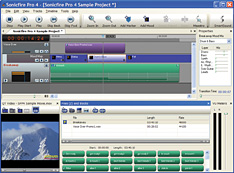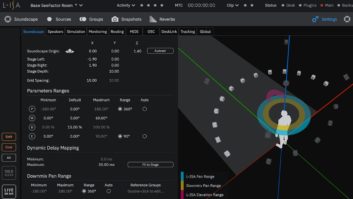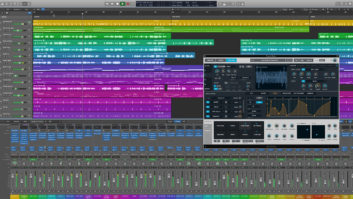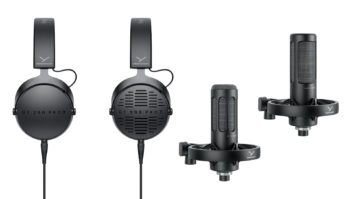
Sonicfire Pro 4 is the latest incarnation of SmartSound’s Sonicfire Pro software series for creating royalty-free music for video and other projects. Entry-level versions of the program have been included in video-editing packages from the likes of Adobe, Avid and Ulead for some time. The latest stand-alone version improves on Version 3 by adding more control over the mix, multilayer tracks from the Strata Series sound library and what Smart Sound calls “mood mapping”: essentially, an automated way to break down the mix and turn various combinations of instruments on and off with automated transitions along the timeline. It is cross-platform-compatible for Mac and PC, and includes Universal Binary support.
Sonicfire Pro 4 features mood mapping, a way to mix and automate tracks.
AND AWAY WE GO
This was my first time using a SmartSound product, and I found it very easy to get in the flow and start customizing tracks. For the test, I used the 3GB Mega Bundle ($799), which contains music from SmartSound’s separately priced libraries that are optimized for film, TV and corporate applications. Once the disks were loaded, the performance was quite good on both my aging Pentium 4 system and a newer Dual-Core system. Ultra 320 SCSI drives work well with this kind of app. You can search the library by style, instrument and intensity, and then mark your favorites. As you get more familiar with the library, you can return to music that suits your taste. Once you find something that appeals to you, bring it into the multitrack timeline view and get started on your music creation.

Edit Expertise:
Compose Your Own
Read more about soundtrack-creation options at digitalcontentproducer.com
First select whether the track should have a beginning and ending, or if it should be a loop. Even if you’re not sure of the necessary length, simply dump in the track and drag the edges right or left to make it shorter or longer as you experiment on the fly (with a slight delay) to “rebuild” the track. The app is also smart enough to snap to the natural breaks in the song when you shrink and expand the tracks, so the result is always musical.
I’M IN A MOOD
The mood mapping feature is essentially automated mixing and selection of tracks. The moods include Full, Background, Dialog, Heavy, Light, Rhythm Only, Atmosphere, etc. Moods are inserted by clicking on the mood map in the timeline that runs along the top of the tracks. A shift in mood will change the tracks’ instrumentation and volume.
Sonicfire creates a transition between moods, which works pretty well. Of course, you can customize the length of the transition or remove it for those times when an abrupt change is preferred, such as when you are moving from the sparse Atmosphere to the full mix where all tracks are activated. You can also assign a volume level to each instrument in each change of mood. The mood mapper serves as a jumping-off point and is a handy time-saver. This feature is great for engineering types who are MIDI- and compositionally handicapped. You can exercise your mixing chops while leaving the music creation to the application.
TRACKS FOR PICTURE
I used Sonicfire Pro 4 to create tracks for a video where the music had to be replaced and remixed with the dialog. About half of the music I used in the final project came from the Guitar Grooves library in the Mega Bundle. I simply timed the required tracks and used the mood mapper to create the desired mix. After a little sweetening, I replaced the mix in the video with the royalty-free tracks; the results were great. With judicious use of plug-ins and effects, the library becomes even more versatile.
Sonicfire Pro 4 works with a wide range of standard audio and video files, including WAV, AIFF, MP3, AVI, MOV, MPEG and SmartSound’s SDS and SSUP files. You can add tracks from your own library of samples and musical phrases, and bring in video as a reference for mixing in the multitrack view. The final mix can be exported as discrete instruments on separate tracks or as a mix for further processing.
IS IT FIRED UP?
I enjoyed using Sonicfire Pro 4; however, I’d like to see SmartSound make better use of the right mouse-click to allow instant access to editing from within the timeline view. There were a few times when I anticipated a menu option would be available, but it wasn’t. Also, the first time a new sound library is located on the DVD drive, you’re given the option of copying the library to your hard drive. If you decline to do so the first time around, the option is no longer available.
In the end, it boils down to the quality of the sound libraries, and SmartSound’s new Strata Series holds its own. Some of the stuff could be classified as B-grade, suffering from too much processing and dated riffs, but overall, you get your money’s worth with the Mega Bundle. If you don’t want to invest in the über-library at the time of purchase, you can go with the Standard Edition ($199), which includes two multilayer discs from the Strata Series. SmartSound has done a nice job of making Sonicfire Pro 4 easy to use and hiding its power under the hood. By letting Sonicfire Pro 4 do the work of the composer and mood-mapping the composition to my video, I was able to turn around a project that would have taken much longer if I had to do everything from scratch.
SmartSound, 800/454-1900, www.smartsound.com.
Rick Spence is the owner of AVT Pro, a production company in the Silicon Valley.







